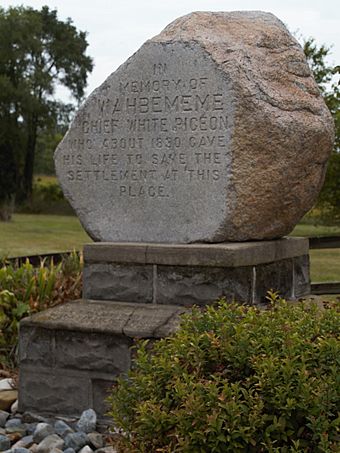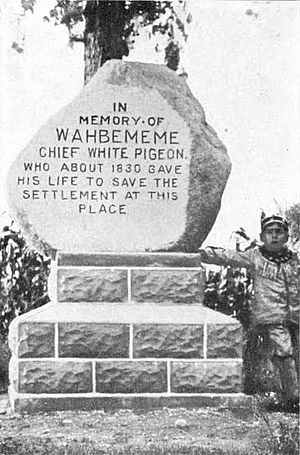Wahbememe Burial Site and Monument facts for kids
Quick facts for kids |
|
|
Wahbememe Burial Site and Monument
|
|
 |
|
| Nearest city | White Pigeon, Michigan |
|---|---|
| Area | 1.2 acres (0.49 ha) |
| Built | 1909 |
| NRHP reference No. | 95000867 |
| Added to NRHP | July 21, 1995 |
The Wahbememe Burial Site and Monument, also known as the Chief White Pigeon Monument, is a special place in Michigan. It is located where U.S. Routes 12 and 131 meet, close to the town of White Pigeon, Michigan. This monument marks the burial spot of a brave Potawatomi chief named Wahbememe. He was also known as White Pigeon. He passed away around the year 1830.
This important site was added to the National Register of Historic Places in 1995. Today, the area around the monument is called Wahbememe Memorial Park. It's a place where people can learn about history and remember Chief White Pigeon's story.
Contents
What Does the Monument Look Like?
The burial site of Chief Wahbememe is on a small hill inside a park. This park also has memorials that honor soldiers who have served.
The monument itself is a large granite boulder, about eight feet tall. It sits on a strong concrete base. The base has three layers, with the bottom part being wider and the top part being narrower. One side of the big boulder is smooth. On this smooth part, there is a special message carved into the stone.
The message on the boulder says:
Below the boulder, on the concrete base, there is another message. It says:
The Story of Chief White Pigeon
In the late 1700s and early 1800s, the Potawatomi people controlled a large area. This land was around the southern part of Lake Michigan, including where the monument stands today. Around the year 1800, Wahbememe (White Pigeon) was a chief of a Potawatomi village. His village was located west of this spot, near the St. Joseph River.
Chief Wahbememe was an important leader. He was one of the chiefs who signed the Treaty of Greenville in 1795. This treaty was an agreement between the United States and several Native American tribes.
Chief White Pigeon During the War of 1812
During the War of 1812, the Potawatomi people often sided with the British. It is said that Chief Wahbememe worked as a messenger. He carried messages between different Potawatomi groups and other important leaders like Main Poc and Tecumseh. In 1815, American soldiers captured him. After this, not much more is known about Chief Wahbememe. He passed away sometime before the first European settlers arrived in the White Pigeon area in 1827.
Early Settlers and the Grave Site
The town of White Pigeon was the first lasting settlement in southern Michigan. This was outside of the areas known as Wayne and Washtenaw counties. The first settlers arrived in 1827. In 1829, the area became known as White Pigeon Township.
That same year, a man named Mr. Earl claimed the land where the monument is now. The Potawatomi people told him that Chief Wahbememe was buried there. Mr. Earl built a house on the spot. However, the Potawatomi quickly burned it down. So, Mr. Earl built his house somewhere else. He marked the chief's burial spot with a poplar tree.
The Legend of Chief White Pigeon's Sacrifice
The grave was a well-known landmark to the first settlers. In 1839, a local newspaper even wrote a short story about the grave. Over time, a popular story grew about Chief Wahbememe. The legend says that around 1830, he went to a meeting near Detroit. There, he learned about a plan for an attack on the White Pigeon settlement.
According to the story, Chief Wahbememe ran all the way back to White Pigeon to warn the settlers. He arrived just in time to save them. After giving his warning, he collapsed and died. This brave story is honored on the monument. However, it is probably not true. We know that Chief Wahbememe's grave was already there when White Pigeon was first settled.
Building the Monument
By 1877, people in the area wanted to build a monument at the grave site. There was a lot of talk about it, but nothing happened until 1909. That year, a women's club from White Pigeon, called the Alba Columba Club, raised money. They wanted to build a proper monument.
A large boulder was brought to the site. The monument was officially revealed on August 10, 1909. A six-year-old boy named Willie White Pigeon unveiled it. He was a direct descendant of Chief Wahbememe. More than 4,000 people came to watch the ceremony.
Creating the Memorial Park
Even after the monument was built, it was still on private land. In 1922, the landowners, Albert G. and Claudia E. Wade, gave permission for a small piece of land to be used as a park. They worked with the St. Joseph County Board of Road Commissioners. This led to the creation of what is now the Wahbememe Memorial Park.
In 1986, the farm that included the site was divided up to make an industrial park. The new owners of the land then gave the park property to the St. Joseph County Historical Society. The monument was honored again in a special ceremony on July 11, 1987.




